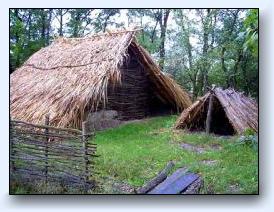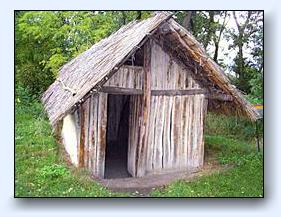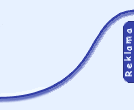
 |
|
 Send as an electronic postcard  Send as an electronic postcard  Send as an electronic postcard  Send as an electronic postcard |
|||||||||||||||
|
You are entering the Archeological Open-Air Museum in Březno near Louny. The site originated as a result of longterm archeological research begun in the 50's. The findings from various periods of the primaeval and historic ages led the author of the research, PhDr. Ivana Pleinerová, CSc., to rest the ancient methods and skills in building by way of experiment, and to test the function of such buildings. The experiments carried out in Březno in the 80's and the early 90's resulted of the ceration of this museum. Its scientific value is recognized worldwide. The Open-Air Museum in now a part of the District Museum of Louny, whose employees are delighted to welcome you here and hope you will find it a fascinating experience. The so-called long house from the late stonge age (about 4000 B. C., the period of the stroke ornamented ware) with the pile skelet. The side walls are made from hewn planks, the front wall is wickered from thick wands and plstered with clay. The door is in the fron wall. The ground plan is of a trapezoid shape, the narrowest back wall facing north, against the prevailing northern winds. The ridge roof declines slightly towards the back wall. It is covered with reed thatch, teid to the rafters with raw cowhide straps. Inside, an open fireside and a deposit bench are located in the south-east part of the house. This house was inhabited as a part of the experiment. The aim was to test the temperature conditions in a house of this size during the winter. The early Slavic hut from the 6th century, partly dug into the ground, is built upon an oblong ground plan with round edges. The interior walls are re-inforced with the wand/spray wickerword. The ridge roof, covered with reed, is supported by two piles bearing the ridge and the rafters. Both walls and the front are plastered with loam, i.e. clay mixed with husks, cut straw, and grass. The loam plaster is applied partly to the roof as well. The hut is equipped with an open fireside in the norhwest corner, and with a simple bed. It is surrounded by a hurdle fence. This hut was the first house built in Březno in the early 80's. It was used for experimental living during the winter. The results of the experiment about the temperature conditions in the houses of the first Slavic inhabitants in our country were of great historical and archeological value. Corn deposit pit from the early Slavic period. It is of cylindric shape with a ridge roof. Such pits were used for storing corn, which was used both for sowing and for immediate consumption. The inside of such a pit was baked and then lined with straw. When filled with corn, the pit was covered with lid consisting of layers of wood, straw, clay, and sods. Thus, the deposit was closed hermetically; inside, a kind of microclimate was established, which protected the corn from decay. Such pits are common in Slavic sites. A load of corn was deposited here experimentally, while the inside tem ... |
||||||||||||||||
|
||||||||||||||||
| ||||||||||||||||
|
May - September: daily except Monday 900 - 1700 Otherwise only after previous negotiation. |
||||||||||||||||
|
10 CZK full * 5 CZK reduced |
||||||||||||||||
|
Without guide, or s vykladem na objednavku, jeden prohlidkovy okru. |
||||||||||||||||
|
Prodej suvenyru. |
||||||||||||||||
|
||||||||||||||||
|
||||||||||||||||
|
||||||||||||||||
| |||||||||||||||||||||||||||
|
 |
|
||||||||||||||